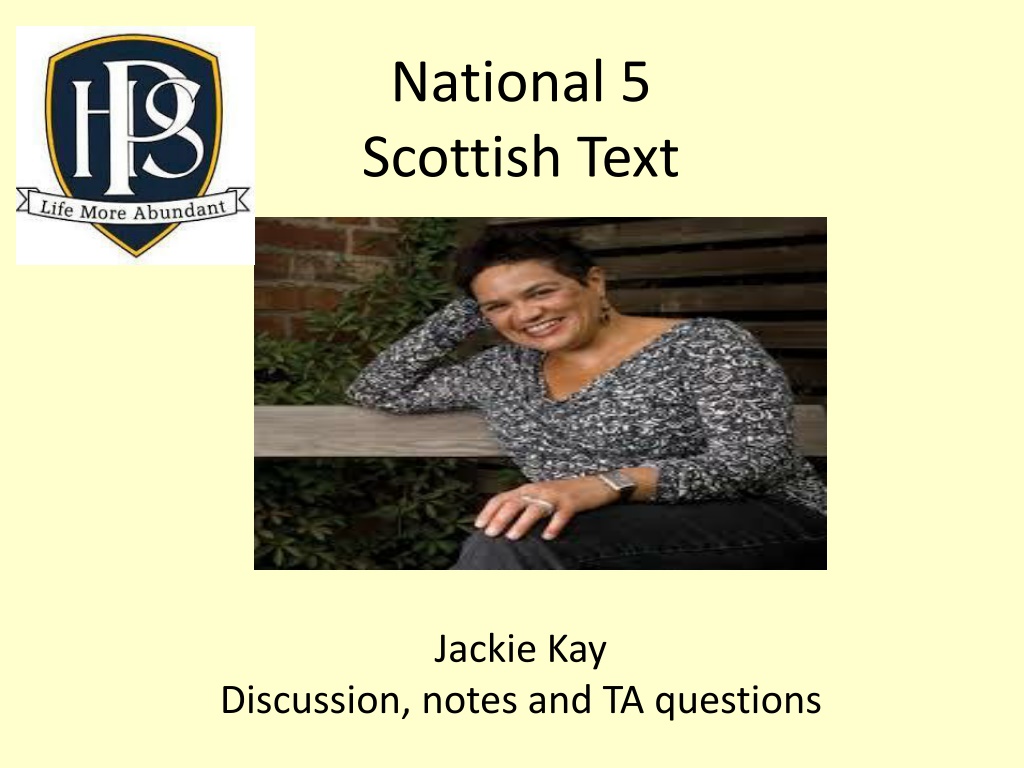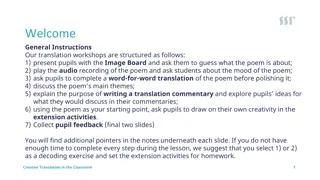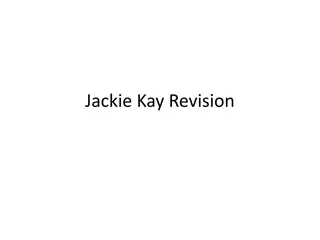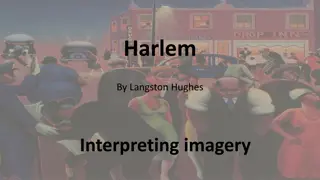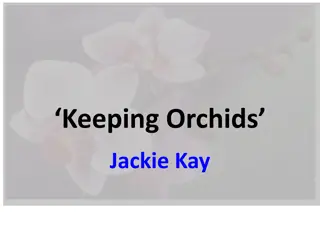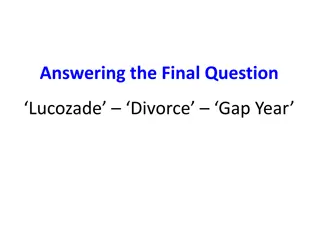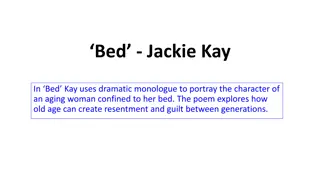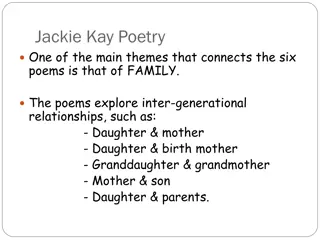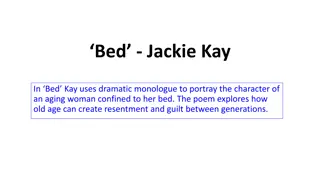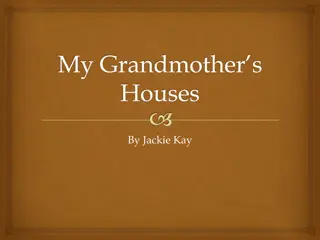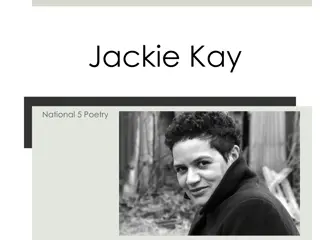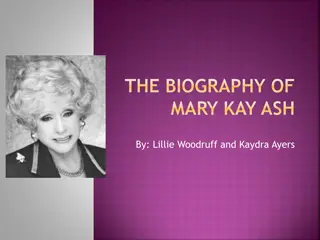Exploring Jackie Kay's 'Gap Year' Poem: Discussion, Analysis, and Themes
Jackie Kay's poem "Gap Year" delves into themes of relationships, birth, identity, and growing up. The poem is divided into two sections with varying tones, incorporating flashback and flash-forward elements. Kay reflects on her relationship with her son, Matthew, during his gap year, showcasing a mix of pride and sadness as he ventures out on his own path. The speaker's musings encapsulate a range of emotions and complexities of motherhood and separation, offering a poignant exploration of maternal instincts and the passage of time.
Download Presentation

Please find below an Image/Link to download the presentation.
The content on the website is provided AS IS for your information and personal use only. It may not be sold, licensed, or shared on other websites without obtaining consent from the author. Download presentation by click this link. If you encounter any issues during the download, it is possible that the publisher has removed the file from their server.
E N D
Presentation Transcript
National 5 Scottish Text Jackie Kay Discussion, notes and TA questions
Who is she? Born Edinburgh, 1961 Scottish Mother & Nigerian Father Adopted by Helen and John Kay at birth; brought up in Bishopbriggs, Glasgow. Studied English at Stirling University Son, Matthew born 1988 Contacted birth mother while pregnant Met birth mother - Elizabeth - in 1991 Met birth father - Jonathan O - in 2003 MBE for services to literature in 2006 Current Makar in Scotland (Poet Laurate)
Gap Year Questions for discussion Why do you think people choose to take a gap year? How would you define Adventure? Write down your definition and be prepared to justify your answer. What feelings do you think parents typically experience as their children grow older and become more independent?
Gap Year Summary Points The speaker of this poem can be said to be Kay herself as it is dedicated and addressed to her son Matthew. She starts by reminiscing about her pregnancy and the subsequent birth of her son. She then flashes forward by eighteen years and her current situation: she is alone at home whilst her son is on a gap year. We learn that she accepts this pursuit but that it saddens her as there is now a vacuum in her life. Her own father s voice punctuates her thoughts with his concerns and this voice of reason, in Scots Language, highlights the gap across the generations as well as the geographic distance. Kay expresses her pride and joy about her son being mature and making his own way in the world. Reference to the baby basket, which frames the poem, focuses on the fact that her maternal instincts will always be part of her..
Gap Year significant aspects Two sections: section 1 has four stanzas of four lines; section 2 has eleven stanzas of four lines and a twelfth stanza of one line Variety of tones Flashback and flash-forward Standard English and Scots Language Main themes: relationships, birth, identity, memory, estrangement, new horizons, growing up
1. Write a summary of what happens in a) section I b) section II 2. Why do you think Kay has split the poem into two sections? 3. How did Kay feel about her child before his birth? Quote evidence from stanza 1 to support this. 4. foot against my heart, elbow in my ribcage What kind of emotions is the baby causing here? 5. How does the poet nurture her child in Stanza 3? Why is this important in our understanding of the rest of the poem? 6. In stanza 5 how does the poet reinforce the change in setting? 7. In stanza 7 how does the poet develop the idea of the journey? 8. a) What tone is created through the grandfather s voice in stanzas 8, 11 and 12? Quote evidence to support your answer. b) Why is the voice of the grandfather important? 9. How do the images in the final stanza help us to understand Kay s feelings towards her son and his gap year? 10. What is important about the structure of the stanzas? Why do you think Kay chose to use this structure? 11. Who did Kay write this poem for? Who is her intended audience and why do you think so?
Questions for discussion What words would you use to describe orchids? This poem is about Kay meeting her birth mother. What kind of emotions do you think people who are adopted experience when being reunited with their birth parents? Why? Think about times when you have met someone new for the first time. How did you feel? What was the meeting like?
Keeping Orchids Summary points The speaker of the poem is a daughter who is reflecting on a first meeting with her birth mother. The birth mother has given her flowers and these become a symbol of the relationship between the mother and child. The daughter is deeply upset during and after this meeting and refers to the basic information she has gleaned about her background but also indicates that there are many untold secrets. The meeting fades and quickly becomes an increasingly distant memory. Instead of gaining a sense of belonging, the speaker feels alienated and uneasy. The poem ends on a sinister note but she knows she has to move on. The orchids represent the fragility and transient nature of life and relationships.
Keeping Orchids Significant Aspects Dramatic monologue Fourteen couplets and a final single line Mixture of both past and present tenses Flashback in present tense Transferred epithet Symbolism Main themes: relationships, identity and belonging, memory, pain and suffering, secrets, adoption
1. 2. 3. Where did the orchids come from? What effect does the use of enjambment in line 2 have? What idea is the poet trying to get across with the image closed as secrets in line 3 In stanza 3, 4 and 5 how does the poet s word choice help you to understand her feelings towards her mother? Give evidence to support your answer. All the broken waters. What water, other than the water from the vase, could the poet be referring to and why? Quote a word or phrase which shows Kay s emotional frustration in stanza 5. What is unusual about the description of the unopened buds in stanza 6? In stanza 7 what techniques are used to highlight the way the memory of the visit is fading? Why is the watch the mother is wearing important? How do you think Kay feels about it and why? 10. Why do you think the flowers are described as hanging their heads and growing old? (lines 18-19) 11. What do you think the writer is referring to in line 24 when she talks about Her secret life ? 12. Why do you think time is personified in stanza 13? 13. What do the final three lines show about Kay s attitude towards her adoption? 4. 5. 6. 7. 8. 9.
Questions for discussion Which words would you use to describe your grandmother? Caring Traditional Stern Humorous Charitable Wise Hard-working Brave Sensitive Patient How do you feel about your grandmother? Responsible Old-fashioned What are the stereotypical images of grandmothers?
MGH Summary points The speaker of the poem is a young child who is reminiscing about visits to her grandmother s houses. The grandmother once lived in a tenement property and was displaced (as part of the urban renewal programme mid 20thCentury) to a high rise property. The child also mentions the houses her gran cleans for a living and their regular visits to church: God s house. The grandmother is defined by these houses and knows her place in society. Unlike the child, she is ignorant of the superficiality and inherent racist attitudes of those around her. The poem is framed with ideas of death and illness which are always on the periphery of our lives.
My Grandmothers Houses Significant Aspects Monologue Related in present tense Three sections each with stanzas of varying lengths Conversational Free verse Main themes: relationships, displacement, class division, illness and death, transient nature of life
1. Briefly identify the three houses being described in each section of the poem. 2. Explain what is happening in the first half of the poem. Give evidence to support your answer. 3. Quote examples of expressions from the first section which are expressions said by the grandmother and now being quoted by the poet. What does each expression suggest about her grandmother? 4. Comment on what is suggested by the following images: words like conscientious objector The sideboard solid as a coffin 5. Which word in section 2 suggests that it takes her grandmother a while to like her new home? 6. What aspects of the new house does her grandmother come to enjoy? 7. What do we learn about her grandmother s character in this second stanza? Quote from the poem to provide evidence for your claims. 8. In whose house is the final section of the poem set? 9. What do we learn about her grandmother s character in the third stanza? Quote from the poem to provide evidence for your claims. 10. What is suggested by the short final stanza?
Questions for discussion What does Lucozade symbolise for many people? How do you feel about having to visit people in hospital? How would you feel about being in hospital for a prolonged period of time?
Lucozade Summary Points The title of this poem indicates that it will be about Lucozade, the traditional aid to recovery . Instead, it focuses on illness and the sixteen-year old speaker who is visiting her mum in hospital. She is clearly sad and upset about the whole situation and fears that her mum could die. As her mother recovers from her anaesthetic, she makes demands on the girl and requests that certain items be removed from her bedside locker and luxuries be brought to her instead. To the girl, this is an indication that her mother is recovering and she leaves in a much happier frame of mind. However, the ending is ambiguous and could be read either as the mother making a recovery or that this has been the final visit.
Lucozade Significant Aspects Seven stanzas of four lines each and a final single line Some rhyming patterns (end and internal) Present tense Dialogue, memory and ambiguity Nostalgic, humorous and sad Main themes: relationships, childhood, nostalgia, illness and death
1. What does the high bed suggest about the positioning of the speaker and her mother? 2. What is unusual about the expression sad chrysanthemums ? 3. What is suggested about the mother in the fifth line? 4. Comment on the ideas suggested by the metaphor a swarm of eyes (line 9)? 5. What is the purpose of the colon in line 14? 6. What does the nature of her requests in lines 15/16 suggest about the mother? 7. What does the mother really mean when she says grapes have no imagination (line 19)? 8. Why does the speaker clear the cupboard in line 21? 9. What do the cleared items represent to the mother? 10. How has the mother changed since the start of the poem? Quote from the poem to justify your answer. 11. What mood is created in the final line and how is it created?
Questions for discussion How do you think you would feel if you moved home and lost your accent? How do you think you would feel if you had children and they lost their Scottish accent? Is your accent important to you?
Old Tongue Summary points The speaker of the poem is reflecting the loss of their accent and dialect when they moved to England as a child. It is uses Scots dialect words at the beginning, but uses standard English in the subsequent stanzas, to show the change in her vernacular. She is clearly upset, and references her mother s anger that she has changed, and forgotten her roots. She laments in the final lines for her own voice to return.
Old Tongue Significant aspects 3 stanzas Use of Scots dialect Reflecting on past- uses past tense Themes of : loss, identity, childhood, moving, change.
1. From the first stanza, how do you know that the poet has adopted a persona? 2. Who is the persona of the poem? 3. How does the language of the first stanza suggest how the persona feels about her situation? 4. How does the second stanza indicate that there has been a change in perspective? 5. According to the third stanza, how has the accent-change affected their relationship with their mother? 6. What has happened to the persona s perception of her accent changed over time? Give examples from each of the stanzas to support your answer. 7. What are the main emotions being experienced by the persona in throughout the poem? Quote from the poem to justify your choices. 8. What is suggested by the following images, used in the last two stanzas: if I had found my words wandering Out in the English soil, my old words buried themselves 9. What do the final two lines of the poem suggest about the persona s feelings? 10. What does the use of dialect add to this poem?
Questions for discussion What does it mean to be a refugee? How would you feel if you had to leave your home suddenly? Do you think you would be welcomed in to another place or country if you had fled your home? Why?
Whilst Leila sleeps Summary points The title suggests an event taking place while Leila is asleep. We then discover the persona of a frightened mother, who is fleeing, at night, with her infant daughter (Leila), who is in a car seat. She describes her family who are at the other side of the world, which adds to her apprehension. The anonymous mother appears to be petrified, on edge, and fearful of the outcome for her and her daughter. We discover that her identity is removed by men in plain suits , further highlighting the woman is voiceless and vulnerable. However, there is a strong indication of a mother s love and bond between mother and daughter as she sings to soothe her.
Whilst Leila sleeps significant aspects Six stanzas of five lines each Present tense Sentence structure used to enhance feelings of fear. Themes of family, relationships, loss, displacement, belonging, power and control.
1. What atmosphere is established in the opening line? Give a reason for your answer. What do we find out about the persona s mother? What does that tells us about the persona s situation? What evidence is there that the mother has been at her current location for a while? What do we learn about Leila in stanza 3? How does this make you feel? Do you think the mother is expecting the men in plain suits ? Give reasons/ quotes for your answer. What are the main emotions being felt by the person in the poem? How do the language features (WITS) of the poem highlight the mother s feelings and emotions? The men in plain suits appear to treat the mother kindly. What does her reaction to their arrival tell us about her situation? Look at the final two stanzas. How does the mother interact with Leila? What does this tell you about their relationship? 10. How do the language features (WITS) of these final stanzas help you understand the bond between mother and daughter? 2. 3. 4. 5. 6. 7. 8. 9.
